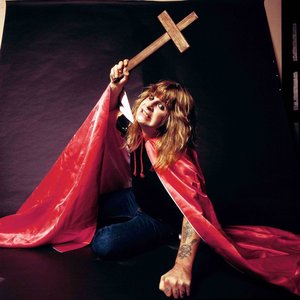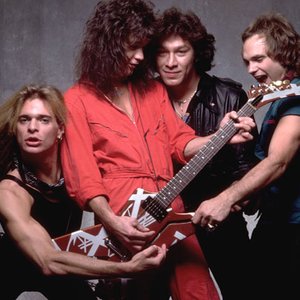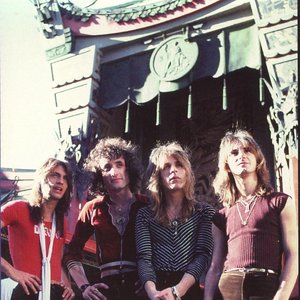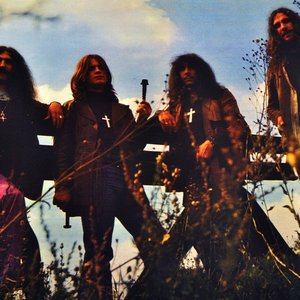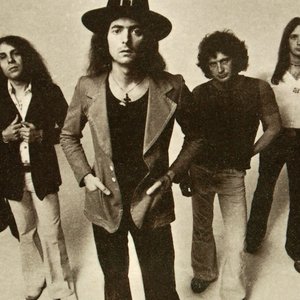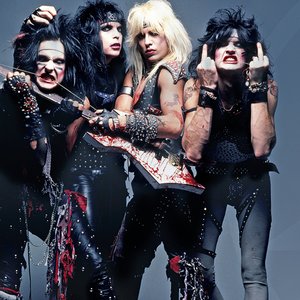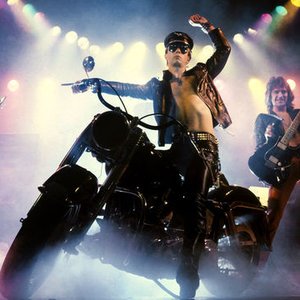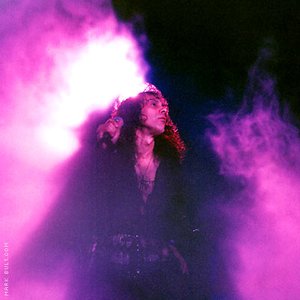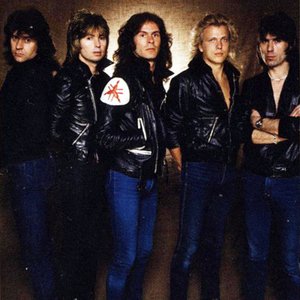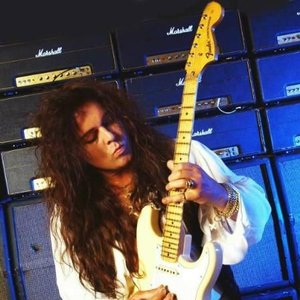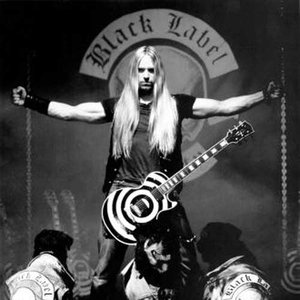Biography
-
Born
6 December 1956
-
Born In
Santa Monica, Los Angeles County, California, United States
-
Died
19 March 1982 (aged 25)
Randall William "Randy" Rhoads (December 6, 1956 – March 19, 1982) was an American heavy metal guitarist who is best known for playing with Ozzy Osbourne. Despite his short career, he is cited as an influence by many contemporary heavy metal guitarists. A devoted student of classical guitar, Rhoads often combined his classical music influences with his own heavy metal style. While on tour with Ozzy Osbourne, he would often seek out classical guitar tutors for lessons.
Contents
Biography
Early life
Rhoads was born on December 6, 1956 at St. John's Hospital in Santa Monica, California. He was the youngest of three children. His older brother, Doug, is a drummer who goes by the name of Kelle Rhoads. His sister's name is Kathy.
When Randy was 17 months old, his father, William Arthur Rhoads, left his mother, Delores Rhoads, and the three children. Mrs. Rhoads has owned and operated the Musonia School of Music in North Hollywood, California since 1949. Rhoads started playing guitar at age 7 on his grandfather's old Gibson "Army-Navy" classical acoustic guitar. According to Rhoads's mother, he learned to play folk guitar, which was a popular way to learn guitar at the time, although he did not take lessons for very long. Rhoads was always evolving toward a hard rock/metal lead guitar style, but he was heavily influenced by classical music as well. This can be heard on tracks like "Dee" (an instrumental he named for his mother Delores), "Mr. Crowley", "Diary of a Madman", "Crazy Train" and "Revelation (Mother Earth).
Quiet Riot
In his early years Rhoads was in a short-lived band called "The Whore". By the time Rhoads was 14, he was in a band called Violet Fox (after his mother's middle name, Violet). Rhoads taught his best friend Kelly Garni how to play bass, and together they formed Quiet Riot when Rhoads was about 17 (according to Rhoads' mother). Kevin DuBrow auditioned for vocalist in Rhoads' kitchen after he convinced Rhoads and Garni to give him a chance. The drummer, Drew Forsyth, was already in the picture and had periodically played with Rhoads and Garni in the past.
Quiet Riot initially played in small bars in Hollywood and local parties in Burbank, eventually playing at the two main L.A. music clubs of the day - the Whisky a Go Go, and The Starwood. While the band had a strong following in the L.A. club scene, they were unable to secure a major recording contract in the United States. Eventually, however, the band was able to land a record deal with Japanese label CBS/Sony Records and Quiet Riot and Quiet Riot II were released in Japan.
Career with Ozzy Osbourne
In 1979, ex-Black Sabbath singer Ozzy Osbourne was forming a new band. Future Slaughter bassist Dana Strum recommended Rhoads to Osbourne. Rhoads got the call for the audition just before his final show with Quiet Riot. He walked in with his Les Paul guitar and a practice amp and started warming up; Osbourne immediately gave him the job. Rhoads recalled later, "I just tuned up and did some riffs, and he said, 'You've got the gig.' I had the weirdest feeling, because I thought, 'You didn't even hear me yet.'" Osbourne described Rhoads' playing as "God entering my life." Rhoads subsequently recommended his friend Greg Leon, who also taught guitar at Musonia for Rhoads' mother, to replace him in Quiet Riot, and then moved to the UK.
They arrived in England in March 1980 to begin working on their first album. The band headed into the studio to record the band's debut album, Blizzard of Ozz. Rhoads' guitar playing had evolved rapidly from his work with Quiet Riot, which has been criticized as being "dull". Propelled by Rhoads' neo-classical guitar work, the album proved an instant hit with rock fans, particularly in the USA. They released two singles from the album: "Mr. Crowley" and the hit "Crazy Train".
The band toured extensively and then quickly wrote and recorded a follow-up album. Diary of a Madman was released shortly thereafter and Osbourne launched another tour with this same lineup. Around this time Rhoads remarked to Osbourne, Tommy Aldridge and friend Kelly Garni that he was considering leaving rock for a few years to earn a degree in classical guitar. In the documentary Don't Blame Me, Osbourne confirmed Randy's desire to earn the degree and stated that had he lived, he didn't believe Randy would have stayed in his band. Friend and ex-Quiet Riot bassist Kelly Garni has stated in interviews that if Randy had continued to play rock, he might have gone the route of more keyboard-driven rock, which had become very popular through the 1980s.
It was at this time that Rhoads was beginning to receive recognition for his playing. Just before his death Jackson Guitars created a signature model, the Jackson Randy Rhoads or Randy Rhoads Pro (though it was recommended to be called the Jackson concorde). Randy received two prototypes - one in black and one in white - but died before the guitar went into production. Rhoads also received the Best New Talent award from Guitar Player.
Death
Rhoads' tomb, San Bernardino, Calif.
Rhoads' tomb, San Bernardino, Calif.
On March 19, 1982, the band was headed to a festival in Orlando, Florida. After driving much of the night, they stopped at the house of Jerry Calhoun, the bus company's owner, in Leesburg, Florida. The driver, Andrew Aycock, took Rhoads and hairdresser Rachel Youngblood on a flight in a Beechcraft Bonanza he had taken without permission. Apparently, during the flight, an attempt was made to "buzz" the tour bus where the other band members were sleeping. They succeeded two times but the third time it went horribly wrong. The right wing clipped the right side of the tour bus by accident, leading to the crash of the plane into Calhoun's nearby mansion, completely destroying its front. Nobody in the mansion was hurt. Rhoads, age 25, was killed instantly, as were Aycock, 36, and Youngblood, 58. It was later determined in an autopsy that Aycock had a trace of cocaine in his system at the time; Rhoads' toxicology test revealed no illicit drugs.
Randy's funeral was held at the First Lutheran Church in Burbank, CA, which he attended as a child. He was interred at Mountain View Cemetery in San Bernardino, California where his grandparents are also buried. At the time, Randy's mother was living in Burbank.
Equipment
* Gibson Les Paul Custom
* Karl Sandoval Polka Dot Flying V
* Original Jackson Randy Rhoads
* Marshall White full stack
* Marshall Black Full stack
* Custom Pedalboard
Posthumous achievements
In 1987, five years after Rhoads' death, Osbourne released Tribute, the only official album featuring Osbourne and Rhoads playing together in concert. Most of the album is a live performance from Cleveland, Ohio, recorded on May 11, 1981. Also used in the recording was Rhoads' guitar solo from a show in Montreal, Canada, recorded on July 28, 1981. That whole show had been broadcast on WMMS-FM, and the King Biscuit Flower Hour, from which it became an extremely popular and fast selling bootleg. The songs "Goodbye to Romance" and "No Bone Movies" from the Tribute album were recorded on the UK Blizzard of Ozz tour at Southampton, on the same date as the Mr. Crowley EP.
Randy was inducted into the Guitar Center Rock Walk (on Sunset Blvd in Hollywood, CA), on March 18 2004. Guests included Dolores Rhoads, Kelle Rhoads, Rudy Sarzo, Ozzy and Sharon Osbourne, Zakk Wylde and Yngwie Malmsteen. In a 2006 Guitar World article, it was mentioned that Rhoads' last name was mistakenly spelled "Rhodes" on his plaque, and by the time it was discovered, there was not enough time to correct the mistake. He is ranked Number 12 on the list of all time greatest guitarists by MUSO and number 85 by Rolling Stone.
As a tribute to Rhoads, Marshall Amplification released the 1959RR at NAMM 2008. The amp is a limited-edition all-white Marshall Super Lead 100 watt head modeled after Randy's own Super Lead amp. Marshall engineers looked extensively at Rhoads' actual amplifier and made the 1959RR to those exact specifications, right down to the special high-gain modification Randy specifically requested when he visited the Marshall factory in 1980.
Influence
Despite his youth and relatively limited recorded work, Rhoads has influenced many notable guitar players including: Zakk Wylde, Alex Skolnick, George Lynch Alexi Laiho, Warren DeMartini, Dimebag Darrell, Dweezil Zappa, Paul Gilbert, Marty Friedman, Buckethead, Chris Impellitteri, Dan Spitz, John Petrucci, Criss Oliva, Tony MacAlpine, Jake E. Lee, Michael Angelo Batio, Carlos Cavazo, Vinnie Vincent and Vinnie Moore.
Artist descriptions on Last.fm are editable by everyone. Feel free to contribute!
All user-contributed text on this page is available under the Creative Commons Attribution-ShareAlike License; additional terms may apply.

